|

by Peter Ripota
April 25, 2025
from
Medium Website
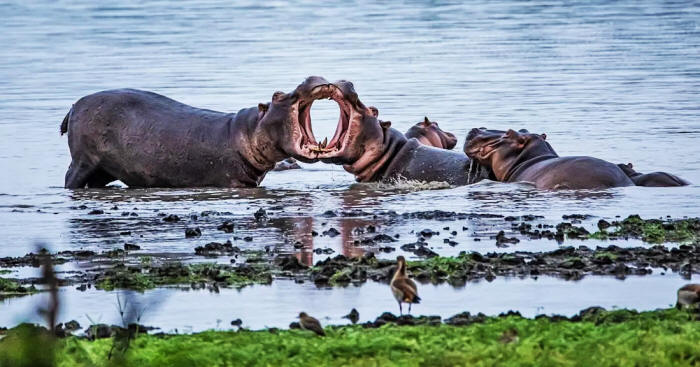
Combat everywhere.
Or is it the beginning of a lasting friendship?
Photo © Birger Strahl on Unsplash
'The world is a constant battle, and nature is red in tooth and claw',
...as the English poet Alfred Tennyson put it in 1850.
Isn't that true?
We only need to watch animal films on television.
Cheetahs hunt
antelopes to devour them afterwards, if hyenas are not faster.
Hyenas, in turn, are mercilessly hunted by lions, who also fight
each other to death.
Eagles eat snakes, snakes strangle eagles, and
giant snakes will swallow a whole pig.
Fighting everywhere!
However, the first animal films came from Walt Disney's workshop,
and he was a gifted storyteller. Today, these films follow the usual
Hollywood formula of sex and crime...:
hot kisses and sharp shots.
Because Americans are still as prudish as the English were in Queen
Victoria's time, there is not much sex to be seen.
So that leaves
the crime part, exploited to the full.
That's why we see so many
hunts and fights in these films.
Or would you like to see what the
animals are doing - dozing and sleeping for 23 hours of the day?
But see for yourself what is going on in nature.
As I write this, I
sit in a meadow before a bull enclosure.
Bees and other insects are
busily collecting nectar; ants are marking a road with their scents,
and butterflies are fluttering from flower to flower, drunk with the
smell they inhale.
Two bulls are measuring their strength, head to
head, but it doesn't look like a fight, more like a game.
A few
crows are sitting on posts and watching with interest, and the black
cat is sniffing the deep grass, maybe catching a grasshopper now and
then.
Where is the fight for existence?
Even in the jungle, things are not as the movies would have us
believe.
If an anaconda swallows a pig, it will last half a year,
maybe even a year.
However, if you want, you can find fighting and
extermination everywhere, even in the extremely courteous,
extraordinarily peace-loving and helpful Arabian Grey Thrush (Turdoides
squamiceps).
These nice birds outdo each other in friendliness.
They, too, have a hierarchy:
the nicer someone is, the higher they
get.
The adults raise the young together, feed each other, pet each
other, warm each other at night, and it is an honor to take on the
dangerous post of guard against eagles and snakes.
This honor is
only given to the highest-ranking male, but others are welcome.
How
did the inconspicuous flycatchers become so extremely altruistic,
especially since the groups are by no means only made up of related
individuals?
Why did Dawkins' "selfish genes" allow such apparent
misbehavior?
Why does everyone stick to these rules when cheating
would only benefit the cheater?
Biologist Amotz Zahavi from Tel Aviv
University investigated the matter and found some Darwinian
explanations.
His findings culminate in the astonishing statement:
Altruism is a selfish activity.
You have to let a sentence like that sink in. You surely know the
work of English author Eric Blair, who published "1984" in 1948
under the pseudonym George Orwell.
In it, he describes a
totalitarian state characterized by "doublethink" and thus produces
such beautiful sayings as "war is peace" or "freedom is slavery."
And now, the biologist mentioned above, representing many of his
profession, has found another saying from the world of the thought
police:
Altruism is egoism...
And that is science?
But we wanted to say something constructive.
Well then, it looks as
if the engines of evolution are not egoism and fighting but
communication and cooperation ("double-c" or c²), i.e.,
talking to
each other and working together.
The German philosopher Friedrich
Nietzsche already recognized this:
In nature, there is not a state of need but abundance and waste,
even to the point of senselessness.
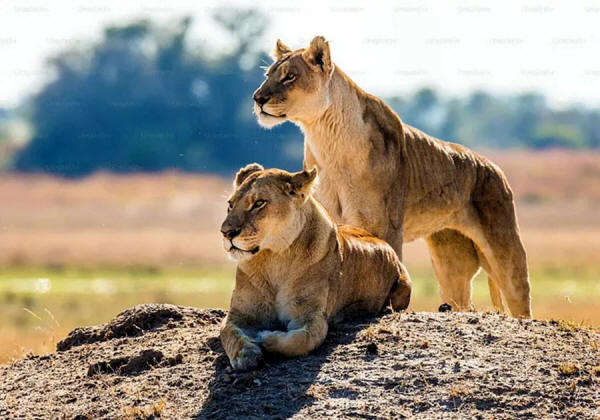
Cooperation everywhere.
Photo © Getty Images via Unsplash
A Russian anarchist essentially advocated the c² idea, Count
Piotr
Alexeyevich Kropotkin, at the beginning of the 20th century.
As an
army officer in Siberia, he observed flora and fauna there for five
years.
The result of his observations:
the main factor for survival
in the harsh northern climate is not rivalry but mutual help.
Because:
If we ask nature, who is the most capable:
those who are always at
war with each other, or those who support each other?
Then we
immediately see that those animals that help each other are the best
adapted - the fittest.
They have a better chance of survival and
reach the highest level of intelligence and body structure.
The social revolutionary Kropotkin also identified mutual help as a
rule among people.
He predicted a trend in the modern world back to
decentralized, apolitical, and cooperative societies in which
everyone could be creative without the influence of bosses,
soldiers, priests, and other rulers.
This is very modern, indeed.
We owe the big breakthrough of the c² idea to a woman.
Lynn Margulis
applied the c² concept to cells.
Biologists have long been puzzled
by one component of cells.
Mitochondria, the energy suppliers of
every cell, have their hereditary structure. They pass on their
genes through the maternal line.
Margulis concluded that
mitochondria were originally independent life forms absorbed by
other living beings, but not eaten.
The two communicated and formed
an alliance to cooperate:
the larger cell protected the smaller one,
which in turn gave energy to the larger one.
There are many other examples of this type of
endosymbiosis:
-
Bacteria and archaea (primitive life forms similar to bacteria)
merged to form mitochondria, the power plants of cells.
While most
bacteria can absorb dissolved organic compounds and use them to
generate energy for their metabolism, archaea lack these transport
systems in their membranes.
Bacteria and archaea probably first
attached themselves to one another, and the latter used the
bacteria's waste products to generate energy.
Before the
relationship could become more intimate, the bacteria had to
transfer their genes for the membrane's transport systems to the
archaea.
Only now were the archaebacteria able to absorb dissolved
organic compounds themselves, which ensured the bacteria's survival
in the host cell.
Over time, the bacteria passed more and more of
their genes to the host so that only a few genes remained, as in the
case of the mitochondrion.
-
Algae and cyanobacteria merged to form higher plants.
A host cell
absorbed cyanobacteria. The host cell could lead a different life by
ingesting the photosynthetically active symbiont because it could
suddenly live on light, water, and CO2.
-
The organelles of many algae have three or four membranes. The
researchers assume that cells were repeatedly devoured but not
digested, etc...
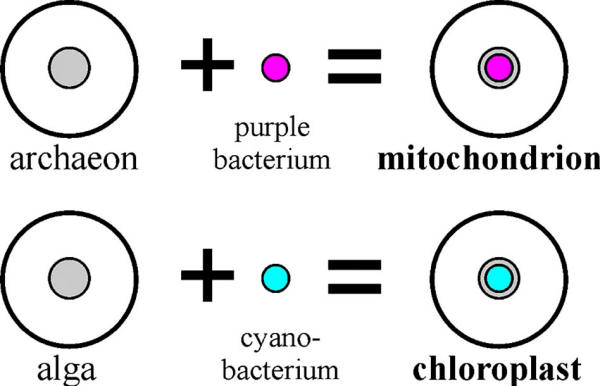
The emergence of
mitochondria
and chloroplasts via "symbiogenesis".
The big cell (left) captured but did not digest
a special bacterium
protected by an additional membrane.
Image by author
In all life forms, there is genuine cooperation between individuals.
Here are a few examples:
-
When conditions become evil for a certain species of amoeba (Dictyostelium
discoideum), they do not eat each other until the fittest remain.
On
the contrary, they join a highly cooperative activity called slime
mold aggregation. They form a fruiting body in which numerous
individuals climb on top of each other until a kind of superpenis is
formed.
Around 20% of the individuals that form this stem die; the
rest turn into spores blown away by the wind and - hopefully - one
day find fertile soil.
The amoebas that formed the hardcore and died
sacrificed themselves entirely unselfishly.
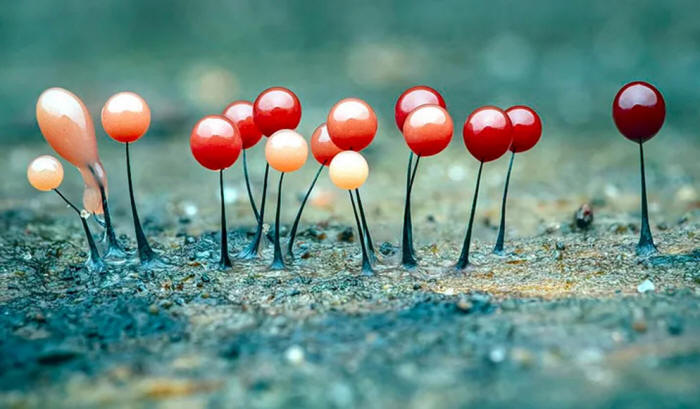
Slime mold (Comatricha nigra).
Source: Creative Commons
-
Yeast cells die a selfless suicide (scientifically: apoptosis) for
altruistic reasons, namely when nutrients become scarce, and
everyone is in danger of starving.
Through such a mass suicide, one
in ten cells or just one in a million cells can survive.
-
The most fantastic manifestation of c², however, is the complex
cities built by mindless microorganisms - in your mold!
These
structures, known as biofilms, are built by bacteria, algae, fungi,
and single-celled organisms (e.g., paramecia).
They join together in
colonies, check the environmental conditions, count their neighbors,
and create three-dimensional city structures comparable in
complexity to modern cities, which, as one scientist once
enthusiastically noted, "look like Manhattan at night."
There are
water pipes, sewers, shipping channels, and assembly areas. An
extreme example is the colonies that live in the stomachs of cows.
Five forms of bacteria ensure the breakdown of cellulose:
Strain 1
converts cellulose into glucose. Strain 2 uses glucose to make
butyrate.
This substance is transformed by the 3rd strain into
acetate, which Strain 4 feeds on and produces methane as a
byproduct.
Oxygen is poisonous for all four strains, and there is
much of it in a cow's stomach.
Therefore, a fifth type of bacteria
creates a protective film around the other four so that they can
work and live undisturbed.
Not only are the life forms that build such cities extremely
primitive (according to our anthropocentric point of view), but they
also belong to different species that certainly do not "speak" the
same language.
These life forms are extreme examples of
communication (they must agree on who builds and manages what) and
cooperation (they manage and supply their city together).
How do
they do it - and above all, why...?
Where is the selection pressure,
the supposedly everywhere effective struggle for existence, the
ruthless selection of the weak, the survival of the strong?
Why do
selfish genes allow such mixing?
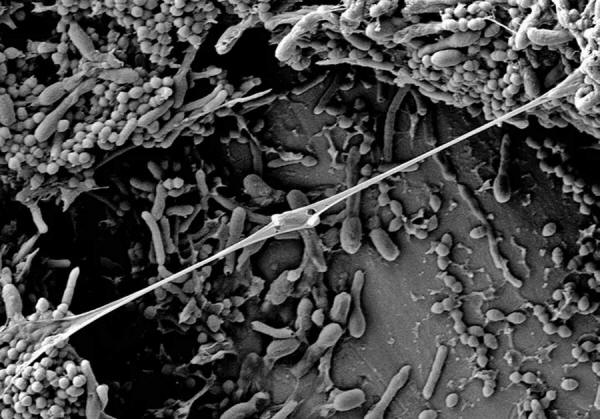
Scanning electron micrograph of a biofilm.
© Krzysztof A. Zacharski,
Creative Commons
Finally,
the ability to communicate and
cooperate also seems to guarantee the economic survival of people and nations.
At least,
that is what the Japanese-American economist Francis Fukuyama ("The
End of History") claims, and he puts forward good arguments.
The
northern and central European peoples are doing well economically:
their c² ability is very well developed...
This applies to the
Americans and Japanese but not to southern Italians and Chinese.
Where everyone distrusts everyone else and only their family members
are trustworthy, neither a flourishing economy nor a cultural life
can develop.
In these countries, there are only three powerful
institutions:
Therefore, according to Fukuyama,
the Chinese will never
become an economic competitor to other states despite their vast
human resources and hard work, despite everybody else telling us
otherwise...
The old ruling dynasty of the Habsburgs knew about this
principle.
Instead of perpetual wars, they pursued a successful
marriage policy as a secondary strategy.
Hence the saying:
"Others may wage wars, but you, happy
Austria, marry!"
Conclusion:
The ability to cooperate seems to offer
long-term
survival advantages...!
|






